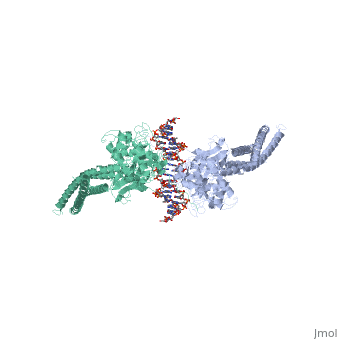STAT3 (Signal Transducer and Activator of Transcription 3) is one of a family of seven homologous STAT proteins that differentially regulate gene expression. STAT 3 is important in both the development of embryos and many functions in adult organisms. [1]
Structure
The STAT3 protein is composed of several structures and its quaternary structure consists of two STAT3 proteins with themselves. [2]
Regulation
STAT3 plays a large role in differential gene regulation. One way that STAT3 can regulate gene expression is through protein-protein interactions with other transcription factors. One major protein-protein interaction for STAT3 is the interaction with nF-κB p65. [3] is characterized by the β-pleated sheet structures. Other protein transcription factors have been shown to interact with STAT3 in similar ways at different locations. STAT3 can also be regulated by phosphorylation. There is a at the C-terminal that plays a large role in transcriptional activation during regulatory events. Phosphorylation of the transcription activating domain's Y residue can be used as a regulatory process. Alternatively, other sites can also be phosphorylated causing other regulatory pathways to occur, such as serine phosphorylation and oncogene activity from STAT3. [4]
DNA-Protein Interactions
The by "clamping" around it. by interacting with the major groove of it. STAT3 (along with other STAT family members) bind to specific DNA sequences. [5] STAT3 has a binding domain with sequences like TTN(5-6)AA. is then what interacts with the STAT3 protein. As shown in the scene, the DNA is bound by the protein in its major groove.

